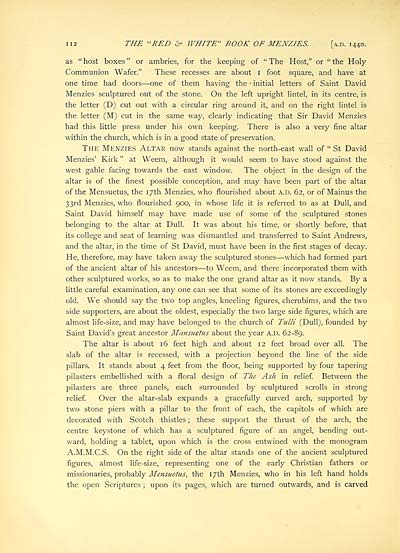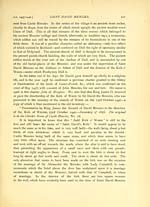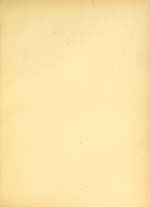Red and white book of Menzies
(166) Page 112
Download files
Complete book:
Individual page:
Thumbnail gallery: Grid view | List view

ii2 THE "RED &■> WHITE" BOOK OF MENZIES. [a.d. 1440.
as " host boxes " or ambries, for the keeping of " The Host," or " the Holy
Communion Wafer." These recesses are about 1 foot square, and have at
one time had doors — one of them having the • initial letters of Saint David
Menzies sculptured out of the stone. On the left upright lintel, in its centre, is
the letter (D) cut out with a circular ring around it, and on the right lintel is
the letter (M) cut in the same way, clearly indicating that Sir David Menzies
had this little press under his own keeping. There is also a very fine altar
within the church, which is in a good state of preservation.
The Menzies Altar now stands against the north-east wall of " St David
Menzies' Kirk " at Weem, although it would seem to have stood against the
west gable facing towards the east window. The object in the design of the
altar is of the finest possible conception, and may have been part of the altar
of the Mensuetus, the 17th Menzies, who flourished about A.D. 62, or of Mainus the
33rd Menzies, who flourished 900, in whose life it is referred to as at Dull, and
Saint David himself may have made use of some of the sculptured stones
belonging to the altar at Dull. It was about his time, or shortly before, that
its college and seat of learning was dismantled and transferred to Saint Andrews,
and the altar, in the time of St David, must have been in the first stages of decay.
He, therefore, may have taken away the sculptured stones — which had formed part
of the ancient altar of his ancestors — to Weem, and there incorporated them with
other sculptured works, so as to make the one grand altar as it now stands. By a
little careful examination, any one can see that some of its stones are exceedingly
old. We should say the two top angles, kneeling figures, cherubims, and the two
side supporters, are about the oldest, especially the two large side figures, which are
almost life-size, and may have belonged to the church of Titlli (Dull), founded by
Saint David's great ancestor Mansuetus about the year A.D. 62-89.
The altar is about 16 feet high and about 12 feet broad over all. The
slab of the altar is recessed, with a projection beyond the line of the side
pillars. It stands about 4 feet from the floor, being supported by four tapering
pilasters embellished with a floral design of The Ash in relief. Between the
pilasters are three panels, each surrounded by sculptured scrolls in strong
relief. Over the altar-slab expands a gracefully curved arch, supported by
two stone piers with a pillar to the front of each, the capitals of which are
decorated with Scotch thistles ; these support the thrust of the arch, the
centre keystone of which has a sculptured figure of an angel, bending out-
ward, holding a tablet, upon which is the cross entwined with the monogram
A.M.M.C.S. On the right side of the altar stands one of the ancient sculptured
figures, almost life-size, representing one of the early Christian fathers or
missionaries, probably Mensuetus, the 17th Menzies, who in his left hand holds
the open Scriptures ; upon its pages, which are turned outwards, and is carved
as " host boxes " or ambries, for the keeping of " The Host," or " the Holy
Communion Wafer." These recesses are about 1 foot square, and have at
one time had doors — one of them having the • initial letters of Saint David
Menzies sculptured out of the stone. On the left upright lintel, in its centre, is
the letter (D) cut out with a circular ring around it, and on the right lintel is
the letter (M) cut in the same way, clearly indicating that Sir David Menzies
had this little press under his own keeping. There is also a very fine altar
within the church, which is in a good state of preservation.
The Menzies Altar now stands against the north-east wall of " St David
Menzies' Kirk " at Weem, although it would seem to have stood against the
west gable facing towards the east window. The object in the design of the
altar is of the finest possible conception, and may have been part of the altar
of the Mensuetus, the 17th Menzies, who flourished about A.D. 62, or of Mainus the
33rd Menzies, who flourished 900, in whose life it is referred to as at Dull, and
Saint David himself may have made use of some of the sculptured stones
belonging to the altar at Dull. It was about his time, or shortly before, that
its college and seat of learning was dismantled and transferred to Saint Andrews,
and the altar, in the time of St David, must have been in the first stages of decay.
He, therefore, may have taken away the sculptured stones — which had formed part
of the ancient altar of his ancestors — to Weem, and there incorporated them with
other sculptured works, so as to make the one grand altar as it now stands. By a
little careful examination, any one can see that some of its stones are exceedingly
old. We should say the two top angles, kneeling figures, cherubims, and the two
side supporters, are about the oldest, especially the two large side figures, which are
almost life-size, and may have belonged to the church of Titlli (Dull), founded by
Saint David's great ancestor Mansuetus about the year A.D. 62-89.
The altar is about 16 feet high and about 12 feet broad over all. The
slab of the altar is recessed, with a projection beyond the line of the side
pillars. It stands about 4 feet from the floor, being supported by four tapering
pilasters embellished with a floral design of The Ash in relief. Between the
pilasters are three panels, each surrounded by sculptured scrolls in strong
relief. Over the altar-slab expands a gracefully curved arch, supported by
two stone piers with a pillar to the front of each, the capitals of which are
decorated with Scotch thistles ; these support the thrust of the arch, the
centre keystone of which has a sculptured figure of an angel, bending out-
ward, holding a tablet, upon which is the cross entwined with the monogram
A.M.M.C.S. On the right side of the altar stands one of the ancient sculptured
figures, almost life-size, representing one of the early Christian fathers or
missionaries, probably Mensuetus, the 17th Menzies, who in his left hand holds
the open Scriptures ; upon its pages, which are turned outwards, and is carved
Set display mode to:
![]() Universal Viewer |
Universal Viewer | ![]() Mirador |
Large image | Transcription
Mirador |
Large image | Transcription
Images and transcriptions on this page, including medium image downloads, may be used under the Creative Commons Attribution 4.0 International Licence unless otherwise stated. ![]()
| Histories of Scottish families > Red and white book of Menzies > (166) Page 112 |
|---|
| Permanent URL | https://digital.nls.uk/96654724 |
|---|
| Description | A selection of almost 400 printed items relating to the history of Scottish families, mostly dating from the 19th and early 20th centuries. Includes memoirs, genealogies and clan histories, with a few produced by emigrant families. The earliest family history goes back to AD 916. |
|---|

